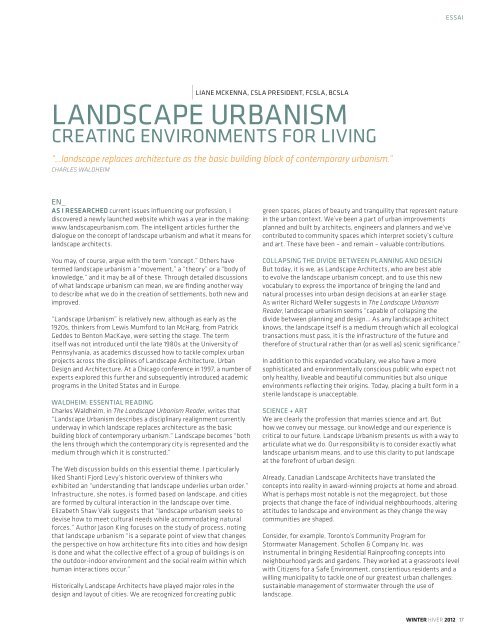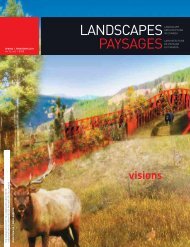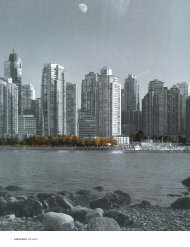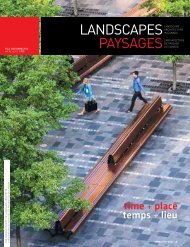trailblazers chefs de file - CSLA
trailblazers chefs de file - CSLA
trailblazers chefs de file - CSLA
Create successful ePaper yourself
Turn your PDF publications into a flip-book with our unique Google optimized e-Paper software.
LANDSCAPE URBANISM<br />
CREATING ENVIRONMENTS FOR LIVING<br />
“...landscape replaces architecture as the basic building block of contemporary urbanism.”<br />
CHARLES WALDHEIM<br />
EN_<br />
AS I RESEARCHED current issues infl uencing our profession, I<br />
discovered a newly launched website which was a year in the making:<br />
www.landscapeurbanism.com. The intelligent articles further the<br />
dialogue on the concept of landscape urbanism and what it means for<br />
landscape architects.<br />
You may, of course, argue with the term “concept.” Others have<br />
termed landscape urbanism a “movement,” a “theory” or a “body of<br />
knowledge,” and it may be all of these. Through <strong>de</strong>tailed discussions<br />
of what landscape urbanism can mean, we are fi nding another way<br />
to <strong>de</strong>scribe what we do in the creation of settlements, both new and<br />
improved.<br />
“Landscape Urbanism” is relatively new, although as early as the<br />
1920s, thinkers from Lewis Mumford to Ian McHarg, from Patrick<br />
Ged<strong>de</strong>s to Benton MacKaye, were setting the stage. The term<br />
itself was not introduced until the late 1980s at the University of<br />
Pennsylvania, as aca<strong>de</strong>mics discussed how to tackle complex urban<br />
projects across the disciplines of Landscape Architecture, Urban<br />
Design and Architecture. At a Chicago conference in 1997, a number of<br />
experts explored this further and subsequently introduced aca<strong>de</strong>mic<br />
programs in the United States and in Europe.<br />
WALDHEIM: ESSENTIAL READING<br />
Charles Waldheim, in The Landscape Urbanism Rea<strong>de</strong>r, writes that<br />
“Landscape Urbanism <strong>de</strong>scribes a disciplinary realignment currently<br />
un<strong>de</strong>rway in which landscape replaces architecture as the basic<br />
building block of contemporary urbanism.” Landscape becomes “both<br />
the lens through which the contemporary city is represented and the<br />
medium through which it is constructed.”<br />
The Web discussion builds on this essential theme. I particularly<br />
liked Shanti Fjord Levy’s historic overview of thinkers who<br />
exhibited an “un<strong>de</strong>rstanding that landscape un<strong>de</strong>rlies urban or<strong>de</strong>r.”<br />
Infrastructure, she notes, is formed based on landscape, and cities<br />
are formed by cultural interaction in the landscape over time.<br />
Elizabeth Shaw Valk suggests that “landscape urbanism seeks to<br />
<strong>de</strong>vise how to meet cultural needs while accommodating natural<br />
forces.” Author Jason King focuses on the study of process, noting<br />
that landscape urbanism “is a separate point of view that changes<br />
the perspective on how architecture fi ts into cities and how <strong>de</strong>sign<br />
is done and what the collective eff ect of a group of buildings is on<br />
the outdoor-indoor environment and the social realm within which<br />
human interactions occur.”<br />
Historically Landscape Architects have played major roles in the<br />
<strong>de</strong>sign and layout of cities. We are recognized for creating public<br />
LIANE MCKENNA, <strong>CSLA</strong> PRESIDENT, F<strong>CSLA</strong>, B<strong>CSLA</strong><br />
ESSAI<br />
green spaces, places of beauty and tranquility that represent nature<br />
in the urban context. We’ve been a part of urban improvements<br />
planned and built by architects, engineers and planners and we’ve<br />
contributed to community spaces which interpret society’s culture<br />
and art. These have been – and remain – valuable contributions.<br />
COLLAPSING THE DIVIDE BETWEEN PLANNING AND DESIGN<br />
But today, it is we, as Landscape Architects, who are best able<br />
to evolve the landscape urbanism concept, and to use this new<br />
vocabulary to express the importance of bringing the land and<br />
natural processes into urban <strong>de</strong>sign <strong>de</strong>cisions at an earlier stage.<br />
As writer Richard Weller suggests in The Landscape Urbanism<br />
Rea<strong>de</strong>r, landscape urbanism seems “capable of collapsing the<br />
divi<strong>de</strong> between planning and <strong>de</strong>sign... As any landscape architect<br />
knows, the landscape itself is a medium through which all ecological<br />
transactions must pass, it is the infrastructure of the future and<br />
therefore of structural rather than (or as well as) scenic signifi cance.”<br />
In addition to this expan<strong>de</strong>d vocabulary, we also have a more<br />
sophisticated and environmentally conscious public who expect not<br />
only healthy, liveable and beautiful communities but also unique<br />
environments refl ecting their origins. Today, placing a built form in a<br />
sterile landscape is unacceptable.<br />
SCIENCE + ART<br />
We are clearly the profession that marries science and art. But<br />
how we convey our message, our knowledge and our experience is<br />
critical to our future. Landscape Urbanism presents us with a way to<br />
articulate what we do. Our responsibility is to consi<strong>de</strong>r exactly what<br />
landscape urbanism means, and to use this clarity to put landscape<br />
at the forefront of urban <strong>de</strong>sign.<br />
Already, Canadian Landscape Architects have translated the<br />
concepts into reality in award-winning projects at home and abroad.<br />
What is perhaps most notable is not the megaproject, but those<br />
projects that change the face of individual neighbourhoods, altering<br />
attitu<strong>de</strong>s to landscape and environment as they change the way<br />
communities are shaped.<br />
Consi<strong>de</strong>r, for example, Toronto’s Community Program for<br />
Stormwater Management. Schollen & Company Inc. was<br />
instrumental in bringing Resi<strong>de</strong>ntial Rainproofi ng concepts into<br />
neighbourhood yards and gar<strong>de</strong>ns. They worked at a grassroots level<br />
with Citizens for a Safe Environment, conscientious resi<strong>de</strong>nts and a<br />
willing municipality to tackle one of our greatest urban challenges:<br />
sustainable management of stormwater through the use of<br />
landscape.<br />
WINTER HIVER 2012 17






